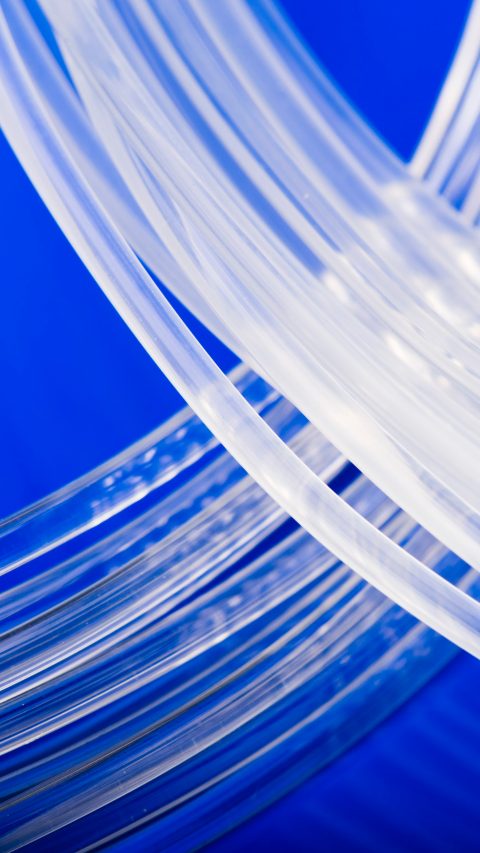Optimized polyamide for fishing lines and nets
The following Ultramid® grades are used for the production of stretched monofilaments such as industrial wires, fishing lines, tennis racket strings, lawn mover monofilaments and bristles.
- Ultramid® B27 E, a low-viscosity polyamide 6, is suitable, either singly or blended with other Ultramid grades, for the production of monofilaments with diameters of up to 0.7 mm. Applications include fishing lines, monofilaments for fishing nets, bristles and fine monofilaments for industrial fabrics.
- Ultramid® B33 L, a medium-viscosity polyamide 6, is the general-purpose grade for the production of fine and medium gauge monofilaments for the fisheries sector and for industrial applications such as filters, paper screening fabric and bristles.
- Ultramid® B33 SL, a medium-viscosity polyamide 6 with a reduced crystallinity for better flexibility and slightly elevated stretchability compared to a standard PA 6 with the same viscosity.
- Ultramid® B33 LXM is a medium viscosity polyamide 6 containing monomer, with a high wax content for flexible, glossy and relatively transparent monofilaments.
- Ultramid® B36 SL is particularly suitable for the production of stretched monofilaments with medium and thicker diameters of up to 5 mm and of bristles.
- Ultramid® B40 SL, a high-viscosity polyamide with a reduced crystallinity, makes medium and thick monofilaments more flexible and more stretchable.
- Ultramid® C33 01 and C40 LX 07 are suitable for the production of high-grade sport fishing lines, hook monofilaments, long lines of up to 2.0 mm and tennis racket strings. High transparency and flexibility with good stretchability are characteristics of these copolyamides.
- Ultramid® C40 L : The high-viscosity copolyamide provides improved mechanical (tenacity, knot strength) and optical (transparency) performance.
- Ultramid® C40 LX and C37 LXC: The high-viscosity copolyamides with extra lubricant are the premium solutions form outstanding gloss and transparency.
Extrusion equipment with a single-screw extruder, spinning pump (precision gear pumps), spinneret (multiple die), water-cooling bath, roll stretching units, hot-water stretching bath and/or hot-air stretching channels is mainly used for extruding monofilaments and bristles. The ratio of the peripheral speeds of the roll stretching units, usually seven-roll sets, corresponds to the stretching ratio which is preferably in the range of 1:4 to 1:6. Depending on the type of monofilament, stretching is carried out in one or more steps. The subsequent "shrinkage or relaxation step" comprises a further hot-air channel and a set of three rolls which run at a lower peripheral speed according to the percentage shrinkage (e.g. 5 to 10%).
Special methods with particular know-how are occasionally also used for the production of monofilaments or wires with large diameters (> 3 mm).
Ultramid® can be processed using standard extrusion equipment. We recommend extruder screws with an L/D ratio of 24-30 and a constant pitch of 1.
Guide values for the screw geometries for extrusion
| Length of sections | ||
Total length |
L |
20-28 D |
Feed section |
LE |
8-9 D |
Compression section |
LÜ |
4-6 D |
Metering section |
LA |
8-13 D1) |

The compression ratio should be between 3:1 and 3.5:1 (Fig. 1). The flight depths themselves depend on the screw diameter D and on the melt viscosity.
Barrier screws are used especially for a constant output. Gentler melting and constant transport of the melt in a narrow output range are possible here.
The screw clearance (radial clearance between the screw and the barrel) should be 0.1-0.2 mm to minimize leakage.
Shear sections at 22-25 D are recommended for screws with a diameter of 90-150 mm.
Screen pack sizes of 400-3600 mesh/cm² are usually essential for the required pressure build-up and good melt homogeneity.
The processing temperature is 270 to 290°C for Ultramid® A grades (PA 66 grades), 240 to 270°C for Ultramid® B grades (PA 6 grades) and 210 to 260°C for Ultramid® C grades (PA 6/66 grades), depending on the product and the process. Appropriately powerful heater bands and drives (e.g. 10 kW heater power and 60 kW drive power for an extruder with a screw diameter of 60 mm), with precise controllers for screw barrels, adapters and dies are required. The best temperatures for a particular production must be determined by trials. Lubrication and nucleation have no significant effect on the resulting melt temperature.

